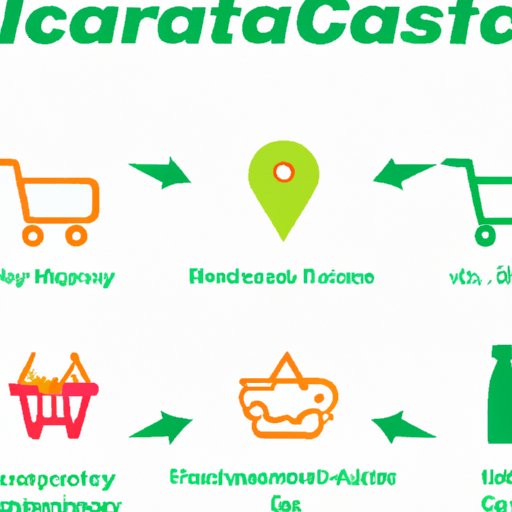Introduction
Instacart is a leading grocery delivery service in the United States. The company allows customers to order groceries online and have them delivered to their door within hours. Launched in 2012, Instacart has quickly become one of the most popular grocery delivery services in the country. But how does Instacart make money? This article will explore Instacart’s business model and explain how the company generates revenue.
Exploring Instacart’s Business Model
At its core, Instacart operates as an intermediary between customers and grocery stores. When customers place an order for groceries, Instacart pairs them with a shopper who will collect the items from the store and deliver them to the customer’s home. In exchange, Instacart charges customers a delivery fee and collects a commission from the grocery store.
Overview of Grocery Partnerships
The first step in understanding Instacart’s business model is to look at its partnerships with grocery stores. According to Forbes, Instacart has partnered with more than 350 retailers across North America, including major chains like Walmart, Target, Whole Foods, Kroger, and Costco. Through these partnerships, Instacart is able to offer customers access to a wide variety of products.
Understanding Instacart’s Delivery Fees and Commissions
In exchange for providing customers with access to groceries, Instacart charges a delivery fee and collects a commission from the grocery store. The delivery fee varies depending on the size of the order and the delivery time. For example, orders placed for same-day delivery may incur a higher fee than orders placed for next-day delivery. Instacart also collects a commission from the grocery store for each order, typically ranging from 10% to 20%.
Analyzing Instacart’s Revenue Streams
Instacart’s primary source of revenue comes from the delivery fees and commissions it collects from customers and grocery stores. However, the company also relies on other sources of income, such as advertising, subscription services, and partnerships with other companies. Let’s take a closer look at each of these revenue streams.
Investing in Instacart’s Advertisements
Instacart offers a variety of advertising opportunities to brands looking to reach Instacart customers. Companies can advertise on Instacart’s website and mobile app, as well as through email campaigns, sponsored product placements, and more. According to Instacart, these ads are seen by millions of shoppers every month, giving companies a powerful platform to reach potential customers.
Examining the Role of Grocery Partners in Monetization
Grocery partners also play an important role in Instacart’s monetization strategy. By partnering with Instacart, grocery stores are able to reach a wider audience of customers, helping to increase sales and drive revenue. Additionally, many grocery stores offer exclusive deals and discounts to Instacart customers, further increasing their appeal to potential customers.
Understanding Instacart’s Delivery Fees and Commissions
Instacart charges customers a delivery fee and collects a commission from the grocery store for each order. The company uses a sliding scale based on the size of the order and the delivery time. For example, orders placed for same-day delivery may incur a higher fee than orders placed for next-day delivery. Instacart also collects a commission from the grocery store for each order, typically ranging from 10% to 20%.
Evaluating Instacart’s Subscription Services
In addition to its delivery fees and commissions, Instacart also offers subscription services to customers. These services include Instacart Express, which offers unlimited free deliveries for a monthly fee, and Instacart Plus, which offers additional benefits such as discounts on select items. Customers can also opt for a pay-as-you-go plan, which allows them to pay only for the deliveries they need.
Assessing Instacart’s Impact on Grocery Shopping Trends
Instacart has had a significant impact on grocery shopping trends. According to a recent survey conducted by the National Retail Federation, nearly half of all shoppers now prefer to buy their groceries online. This shift in consumer behavior has been fueled in part by the convenience and cost savings offered by grocery delivery services like Instacart.
Conclusion
Instacart has revolutionized the way people shop for groceries. By leveraging partnerships with grocery stores, investing in advertisements, and offering subscription services, the company is able to generate significant revenue. Additionally, Instacart’s growing popularity has shifted consumer habits, leading to an increased demand for online grocery shopping. Ultimately, Instacart’s business model provides an effective framework for understanding how the company makes money.
(Note: Is this article not meeting your expectations? Do you have knowledge or insights to share? Unlock new opportunities and expand your reach by joining our authors team. Click Registration to join us and share your expertise with our readers.)
